Chestnut Enterprises Audit: Procedures, Ethics, and Materiality
VerifiedAdded on 2023/06/06
|12
|2169
|380
Report
AI Summary
This document provides a detailed analysis of audit procedures and professional ethics in the context of Chestnut Enterprises. It evaluates the materiality level for the audit based on the provided trial balance, discussing relevant Australian Auditing Standards. The report includes a ratio analysis to identify potential misstatements, specifically focusing on accounts receivable, repair and maintenance expenditures, and overall expenditures. It outlines audit procedures for these accounts and addresses the importance of considering fraud risk according to ASA 240, regardless of the auditor's personal judgment about employee trustworthiness. The report concludes with recommendations to adjust the materiality level, perform substantive audit procedures, and thoroughly investigate fraud risks. Desklib offers this and many more solved assignments for students.
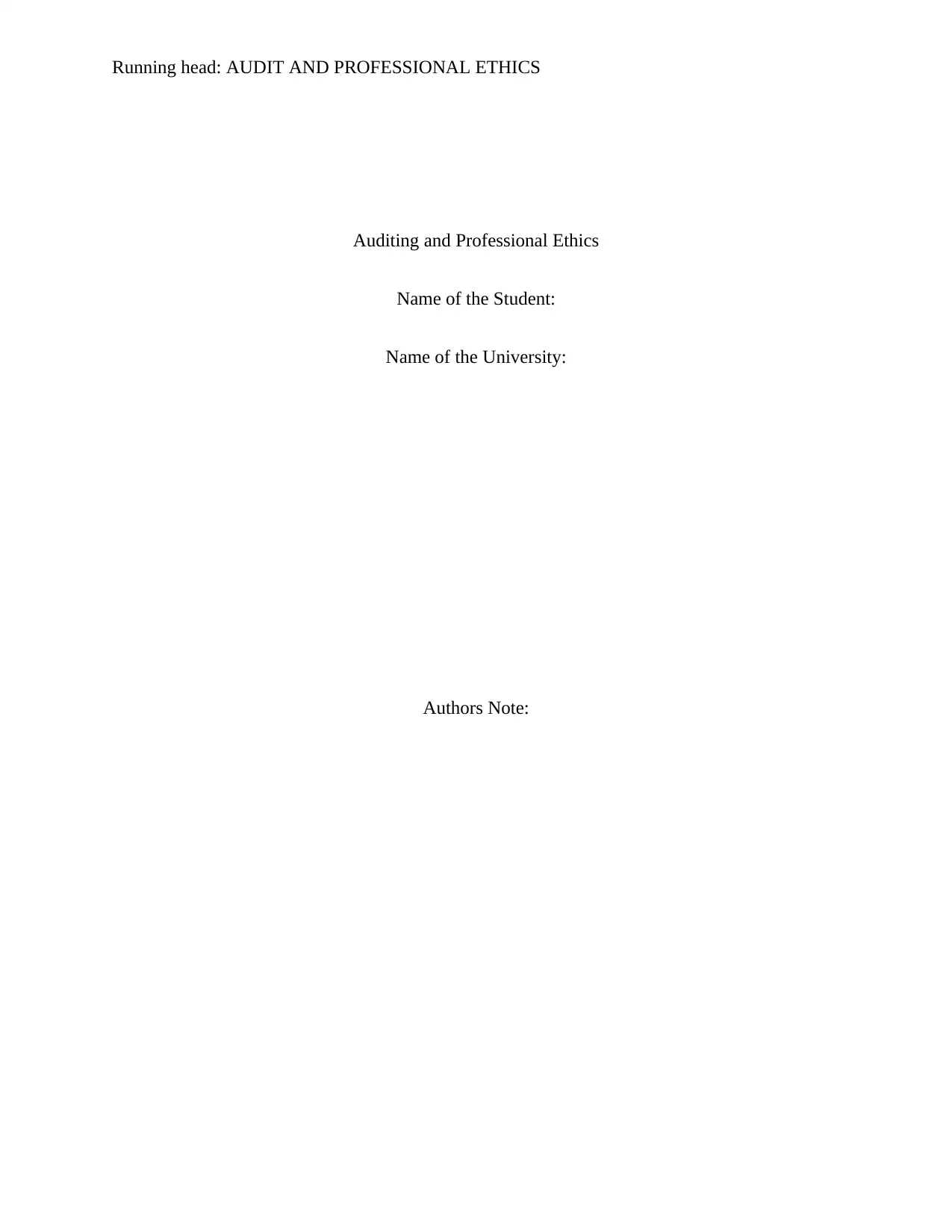
Running head: AUDIT AND PROFESSIONAL ETHICS
Auditing and Professional Ethics
Name of the Student:
Name of the University:
Authors Note:
Auditing and Professional Ethics
Name of the Student:
Name of the University:
Authors Note:
Paraphrase This Document
Need a fresh take? Get an instant paraphrase of this document with our AI Paraphraser
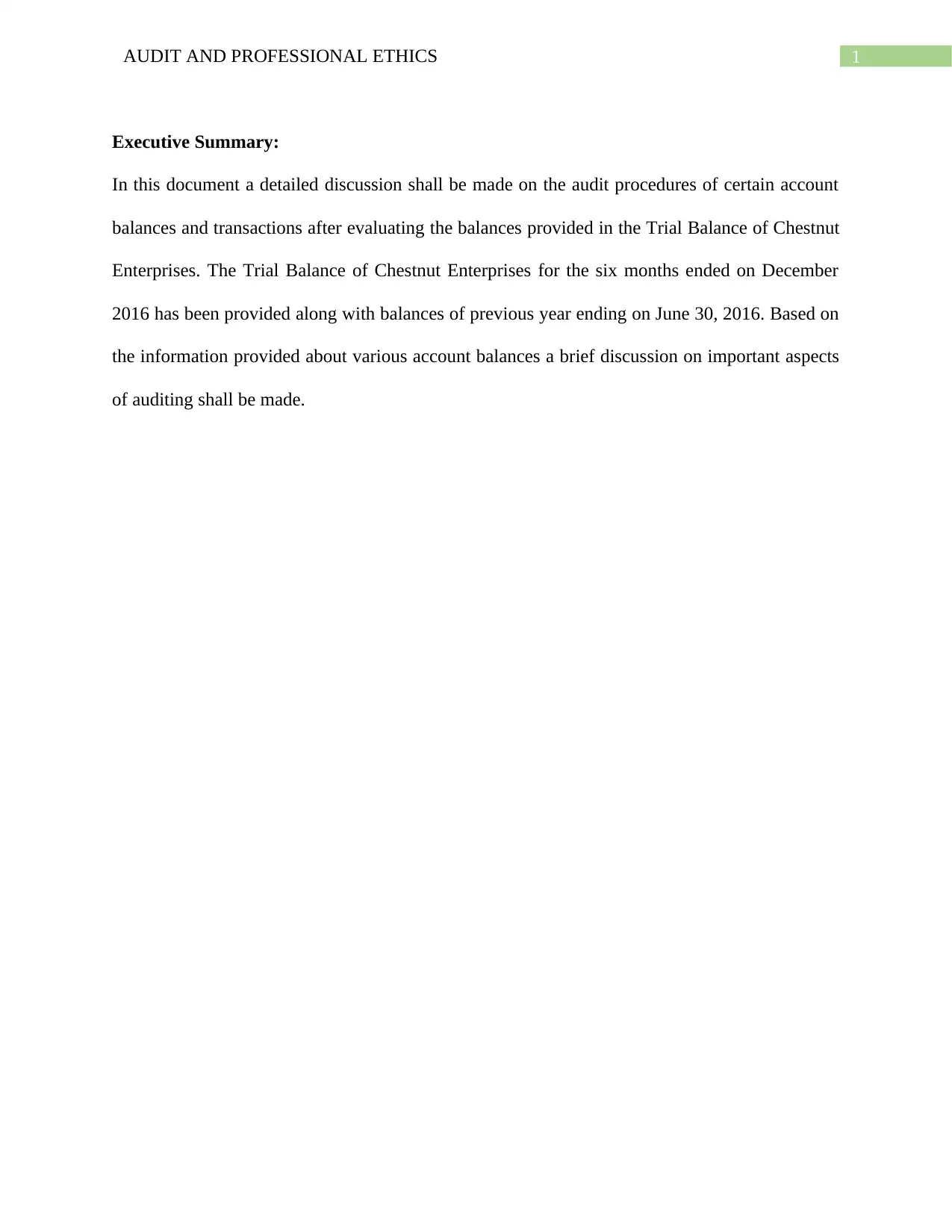
1AUDIT AND PROFESSIONAL ETHICS
Executive Summary:
In this document a detailed discussion shall be made on the audit procedures of certain account
balances and transactions after evaluating the balances provided in the Trial Balance of Chestnut
Enterprises. The Trial Balance of Chestnut Enterprises for the six months ended on December
2016 has been provided along with balances of previous year ending on June 30, 2016. Based on
the information provided about various account balances a brief discussion on important aspects
of auditing shall be made.
Executive Summary:
In this document a detailed discussion shall be made on the audit procedures of certain account
balances and transactions after evaluating the balances provided in the Trial Balance of Chestnut
Enterprises. The Trial Balance of Chestnut Enterprises for the six months ended on December
2016 has been provided along with balances of previous year ending on June 30, 2016. Based on
the information provided about various account balances a brief discussion on important aspects
of auditing shall be made.

2AUDIT AND PROFESSIONAL ETHICS
Contents
Executive Summary:........................................................................................................................1
Introduction:....................................................................................................................................3
Part 1:...............................................................................................................................................3
Part 2:...............................................................................................................................................4
Part 3:...............................................................................................................................................6
Part 4:...............................................................................................................................................7
Part 5:...............................................................................................................................................8
Conclusion:......................................................................................................................................8
Recommendation:............................................................................................................................9
References:....................................................................................................................................10
Contents
Executive Summary:........................................................................................................................1
Introduction:....................................................................................................................................3
Part 1:...............................................................................................................................................3
Part 2:...............................................................................................................................................4
Part 3:...............................................................................................................................................6
Part 4:...............................................................................................................................................7
Part 5:...............................................................................................................................................8
Conclusion:......................................................................................................................................8
Recommendation:............................................................................................................................9
References:....................................................................................................................................10
⊘ This is a preview!⊘
Do you want full access?
Subscribe today to unlock all pages.

Trusted by 1+ million students worldwide
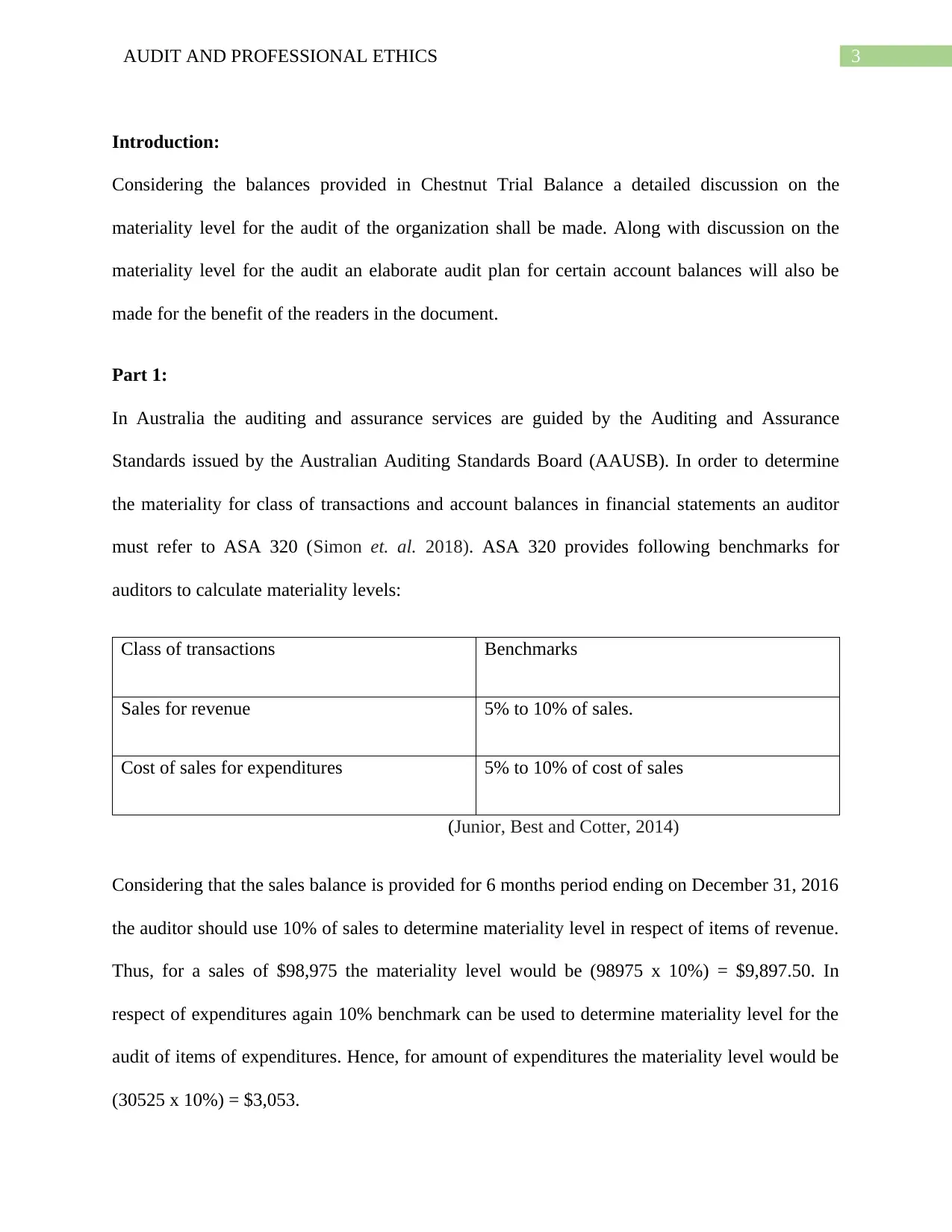
3AUDIT AND PROFESSIONAL ETHICS
Introduction:
Considering the balances provided in Chestnut Trial Balance a detailed discussion on the
materiality level for the audit of the organization shall be made. Along with discussion on the
materiality level for the audit an elaborate audit plan for certain account balances will also be
made for the benefit of the readers in the document.
Part 1:
In Australia the auditing and assurance services are guided by the Auditing and Assurance
Standards issued by the Australian Auditing Standards Board (AAUSB). In order to determine
the materiality for class of transactions and account balances in financial statements an auditor
must refer to ASA 320 (Simon et. al. 2018). ASA 320 provides following benchmarks for
auditors to calculate materiality levels:
Class of transactions Benchmarks
Sales for revenue 5% to 10% of sales.
Cost of sales for expenditures 5% to 10% of cost of sales
(Junior, Best and Cotter, 2014)
Considering that the sales balance is provided for 6 months period ending on December 31, 2016
the auditor should use 10% of sales to determine materiality level in respect of items of revenue.
Thus, for a sales of $98,975 the materiality level would be (98975 x 10%) = $9,897.50. In
respect of expenditures again 10% benchmark can be used to determine materiality level for the
audit of items of expenditures. Hence, for amount of expenditures the materiality level would be
(30525 x 10%) = $3,053.
Introduction:
Considering the balances provided in Chestnut Trial Balance a detailed discussion on the
materiality level for the audit of the organization shall be made. Along with discussion on the
materiality level for the audit an elaborate audit plan for certain account balances will also be
made for the benefit of the readers in the document.
Part 1:
In Australia the auditing and assurance services are guided by the Auditing and Assurance
Standards issued by the Australian Auditing Standards Board (AAUSB). In order to determine
the materiality for class of transactions and account balances in financial statements an auditor
must refer to ASA 320 (Simon et. al. 2018). ASA 320 provides following benchmarks for
auditors to calculate materiality levels:
Class of transactions Benchmarks
Sales for revenue 5% to 10% of sales.
Cost of sales for expenditures 5% to 10% of cost of sales
(Junior, Best and Cotter, 2014)
Considering that the sales balance is provided for 6 months period ending on December 31, 2016
the auditor should use 10% of sales to determine materiality level in respect of items of revenue.
Thus, for a sales of $98,975 the materiality level would be (98975 x 10%) = $9,897.50. In
respect of expenditures again 10% benchmark can be used to determine materiality level for the
audit of items of expenditures. Hence, for amount of expenditures the materiality level would be
(30525 x 10%) = $3,053.
Paraphrase This Document
Need a fresh take? Get an instant paraphrase of this document with our AI Paraphraser
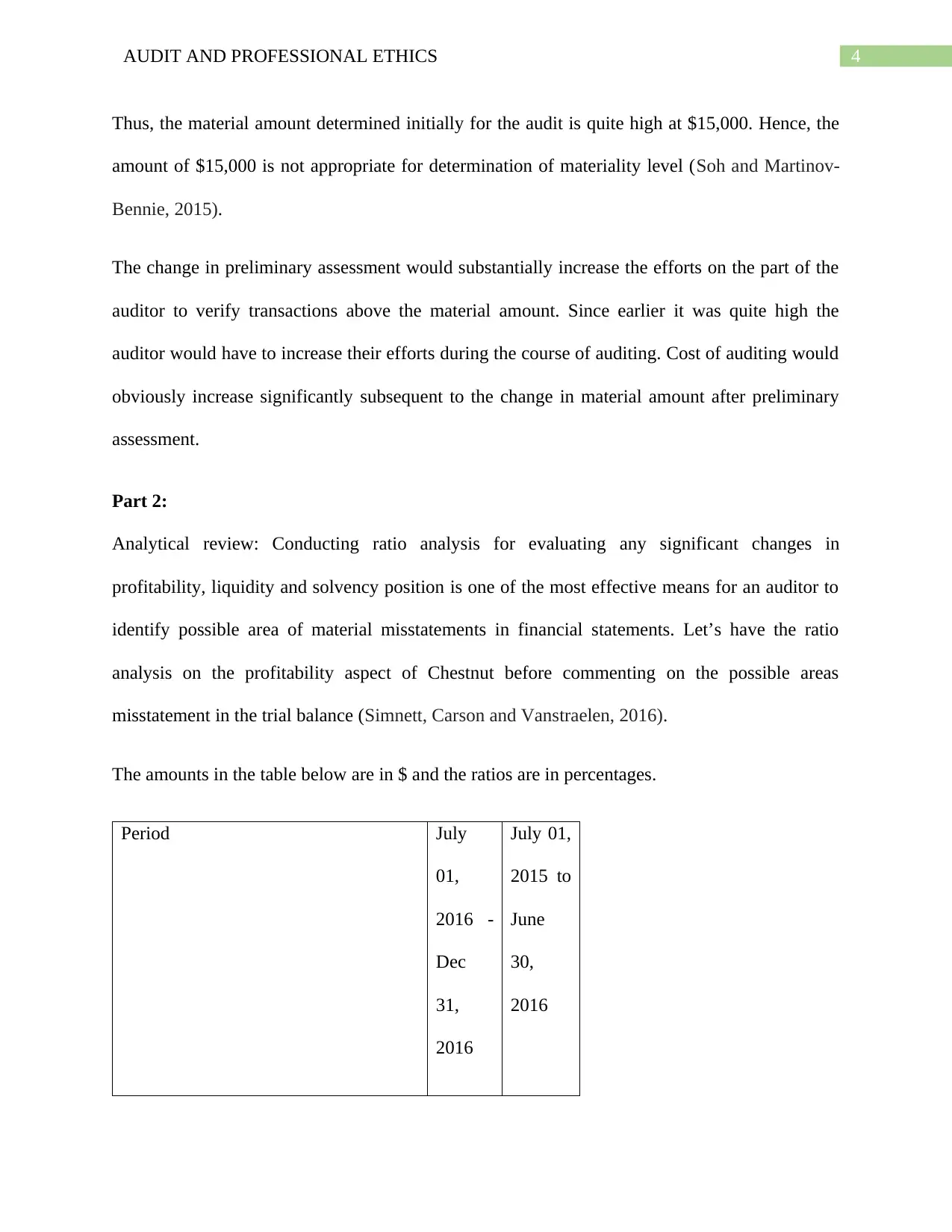
4AUDIT AND PROFESSIONAL ETHICS
Thus, the material amount determined initially for the audit is quite high at $15,000. Hence, the
amount of $15,000 is not appropriate for determination of materiality level (Soh and Martinov-
Bennie, 2015).
The change in preliminary assessment would substantially increase the efforts on the part of the
auditor to verify transactions above the material amount. Since earlier it was quite high the
auditor would have to increase their efforts during the course of auditing. Cost of auditing would
obviously increase significantly subsequent to the change in material amount after preliminary
assessment.
Part 2:
Analytical review: Conducting ratio analysis for evaluating any significant changes in
profitability, liquidity and solvency position is one of the most effective means for an auditor to
identify possible area of material misstatements in financial statements. Let’s have the ratio
analysis on the profitability aspect of Chestnut before commenting on the possible areas
misstatement in the trial balance (Simnett, Carson and Vanstraelen, 2016).
The amounts in the table below are in $ and the ratios are in percentages.
Period July
01,
2016 -
Dec
31,
2016
July 01,
2015 to
June
30,
2016
Thus, the material amount determined initially for the audit is quite high at $15,000. Hence, the
amount of $15,000 is not appropriate for determination of materiality level (Soh and Martinov-
Bennie, 2015).
The change in preliminary assessment would substantially increase the efforts on the part of the
auditor to verify transactions above the material amount. Since earlier it was quite high the
auditor would have to increase their efforts during the course of auditing. Cost of auditing would
obviously increase significantly subsequent to the change in material amount after preliminary
assessment.
Part 2:
Analytical review: Conducting ratio analysis for evaluating any significant changes in
profitability, liquidity and solvency position is one of the most effective means for an auditor to
identify possible area of material misstatements in financial statements. Let’s have the ratio
analysis on the profitability aspect of Chestnut before commenting on the possible areas
misstatement in the trial balance (Simnett, Carson and Vanstraelen, 2016).
The amounts in the table below are in $ and the ratios are in percentages.
Period July
01,
2016 -
Dec
31,
2016
July 01,
2015 to
June
30,
2016
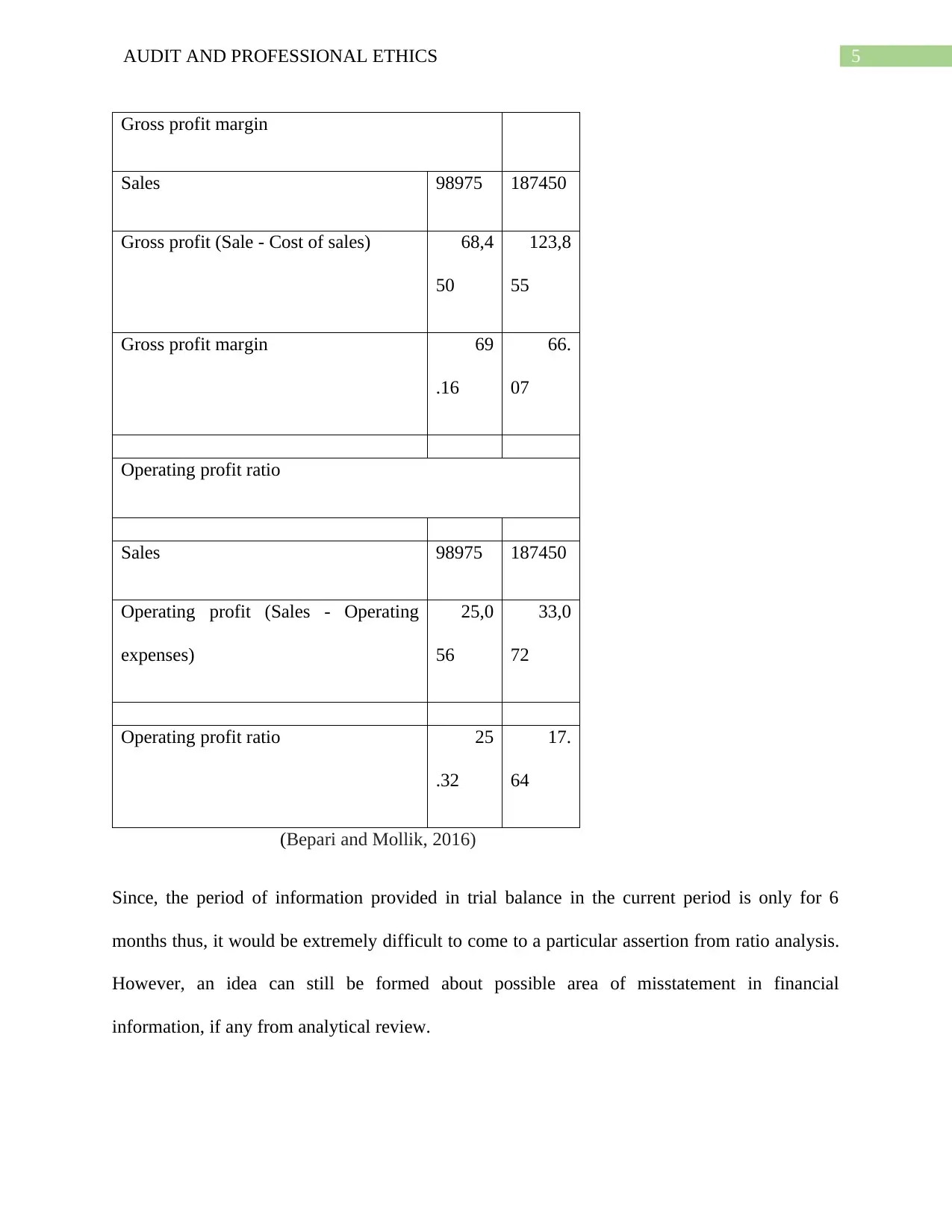
5AUDIT AND PROFESSIONAL ETHICS
Gross profit margin
Sales 98975 187450
Gross profit (Sale - Cost of sales) 68,4
50
123,8
55
Gross profit margin 69
.16
66.
07
Operating profit ratio
Sales 98975 187450
Operating profit (Sales - Operating
expenses)
25,0
56
33,0
72
Operating profit ratio 25
.32
17.
64
(Bepari and Mollik, 2016)
Since, the period of information provided in trial balance in the current period is only for 6
months thus, it would be extremely difficult to come to a particular assertion from ratio analysis.
However, an idea can still be formed about possible area of misstatement in financial
information, if any from analytical review.
Gross profit margin
Sales 98975 187450
Gross profit (Sale - Cost of sales) 68,4
50
123,8
55
Gross profit margin 69
.16
66.
07
Operating profit ratio
Sales 98975 187450
Operating profit (Sales - Operating
expenses)
25,0
56
33,0
72
Operating profit ratio 25
.32
17.
64
(Bepari and Mollik, 2016)
Since, the period of information provided in trial balance in the current period is only for 6
months thus, it would be extremely difficult to come to a particular assertion from ratio analysis.
However, an idea can still be formed about possible area of misstatement in financial
information, if any from analytical review.
⊘ This is a preview!⊘
Do you want full access?
Subscribe today to unlock all pages.

Trusted by 1+ million students worldwide
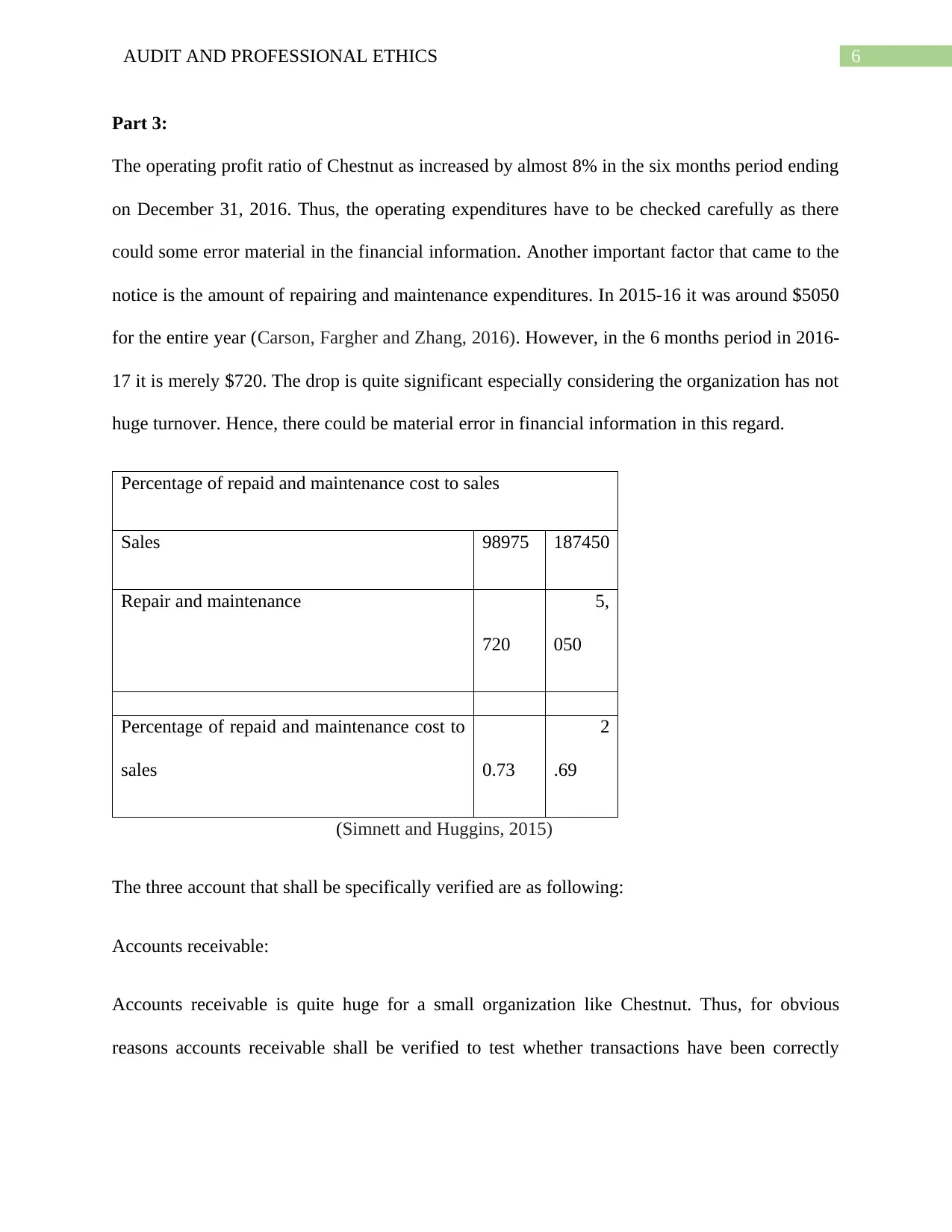
6AUDIT AND PROFESSIONAL ETHICS
Part 3:
The operating profit ratio of Chestnut as increased by almost 8% in the six months period ending
on December 31, 2016. Thus, the operating expenditures have to be checked carefully as there
could some error material in the financial information. Another important factor that came to the
notice is the amount of repairing and maintenance expenditures. In 2015-16 it was around $5050
for the entire year (Carson, Fargher and Zhang, 2016). However, in the 6 months period in 2016-
17 it is merely $720. The drop is quite significant especially considering the organization has not
huge turnover. Hence, there could be material error in financial information in this regard.
Percentage of repaid and maintenance cost to sales
Sales 98975 187450
Repair and maintenance
720
5,
050
Percentage of repaid and maintenance cost to
sales 0.73
2
.69
(Simnett and Huggins, 2015)
The three account that shall be specifically verified are as following:
Accounts receivable:
Accounts receivable is quite huge for a small organization like Chestnut. Thus, for obvious
reasons accounts receivable shall be verified to test whether transactions have been correctly
Part 3:
The operating profit ratio of Chestnut as increased by almost 8% in the six months period ending
on December 31, 2016. Thus, the operating expenditures have to be checked carefully as there
could some error material in the financial information. Another important factor that came to the
notice is the amount of repairing and maintenance expenditures. In 2015-16 it was around $5050
for the entire year (Carson, Fargher and Zhang, 2016). However, in the 6 months period in 2016-
17 it is merely $720. The drop is quite significant especially considering the organization has not
huge turnover. Hence, there could be material error in financial information in this regard.
Percentage of repaid and maintenance cost to sales
Sales 98975 187450
Repair and maintenance
720
5,
050
Percentage of repaid and maintenance cost to
sales 0.73
2
.69
(Simnett and Huggins, 2015)
The three account that shall be specifically verified are as following:
Accounts receivable:
Accounts receivable is quite huge for a small organization like Chestnut. Thus, for obvious
reasons accounts receivable shall be verified to test whether transactions have been correctly
Paraphrase This Document
Need a fresh take? Get an instant paraphrase of this document with our AI Paraphraser
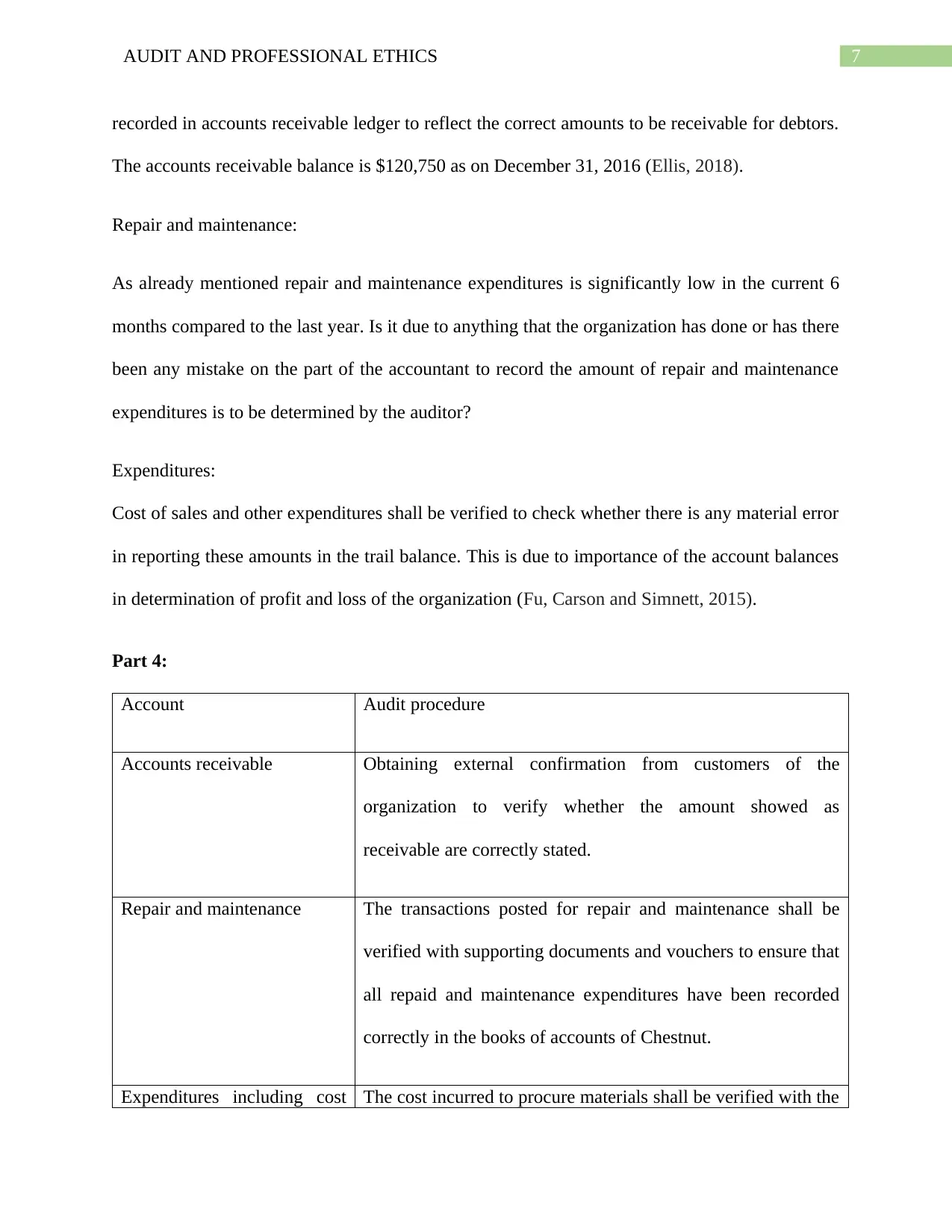
7AUDIT AND PROFESSIONAL ETHICS
recorded in accounts receivable ledger to reflect the correct amounts to be receivable for debtors.
The accounts receivable balance is $120,750 as on December 31, 2016 (Ellis, 2018).
Repair and maintenance:
As already mentioned repair and maintenance expenditures is significantly low in the current 6
months compared to the last year. Is it due to anything that the organization has done or has there
been any mistake on the part of the accountant to record the amount of repair and maintenance
expenditures is to be determined by the auditor?
Expenditures:
Cost of sales and other expenditures shall be verified to check whether there is any material error
in reporting these amounts in the trail balance. This is due to importance of the account balances
in determination of profit and loss of the organization (Fu, Carson and Simnett, 2015).
Part 4:
Account Audit procedure
Accounts receivable Obtaining external confirmation from customers of the
organization to verify whether the amount showed as
receivable are correctly stated.
Repair and maintenance The transactions posted for repair and maintenance shall be
verified with supporting documents and vouchers to ensure that
all repaid and maintenance expenditures have been recorded
correctly in the books of accounts of Chestnut.
Expenditures including cost The cost incurred to procure materials shall be verified with the
recorded in accounts receivable ledger to reflect the correct amounts to be receivable for debtors.
The accounts receivable balance is $120,750 as on December 31, 2016 (Ellis, 2018).
Repair and maintenance:
As already mentioned repair and maintenance expenditures is significantly low in the current 6
months compared to the last year. Is it due to anything that the organization has done or has there
been any mistake on the part of the accountant to record the amount of repair and maintenance
expenditures is to be determined by the auditor?
Expenditures:
Cost of sales and other expenditures shall be verified to check whether there is any material error
in reporting these amounts in the trail balance. This is due to importance of the account balances
in determination of profit and loss of the organization (Fu, Carson and Simnett, 2015).
Part 4:
Account Audit procedure
Accounts receivable Obtaining external confirmation from customers of the
organization to verify whether the amount showed as
receivable are correctly stated.
Repair and maintenance The transactions posted for repair and maintenance shall be
verified with supporting documents and vouchers to ensure that
all repaid and maintenance expenditures have been recorded
correctly in the books of accounts of Chestnut.
Expenditures including cost The cost incurred to procure materials shall be verified with the
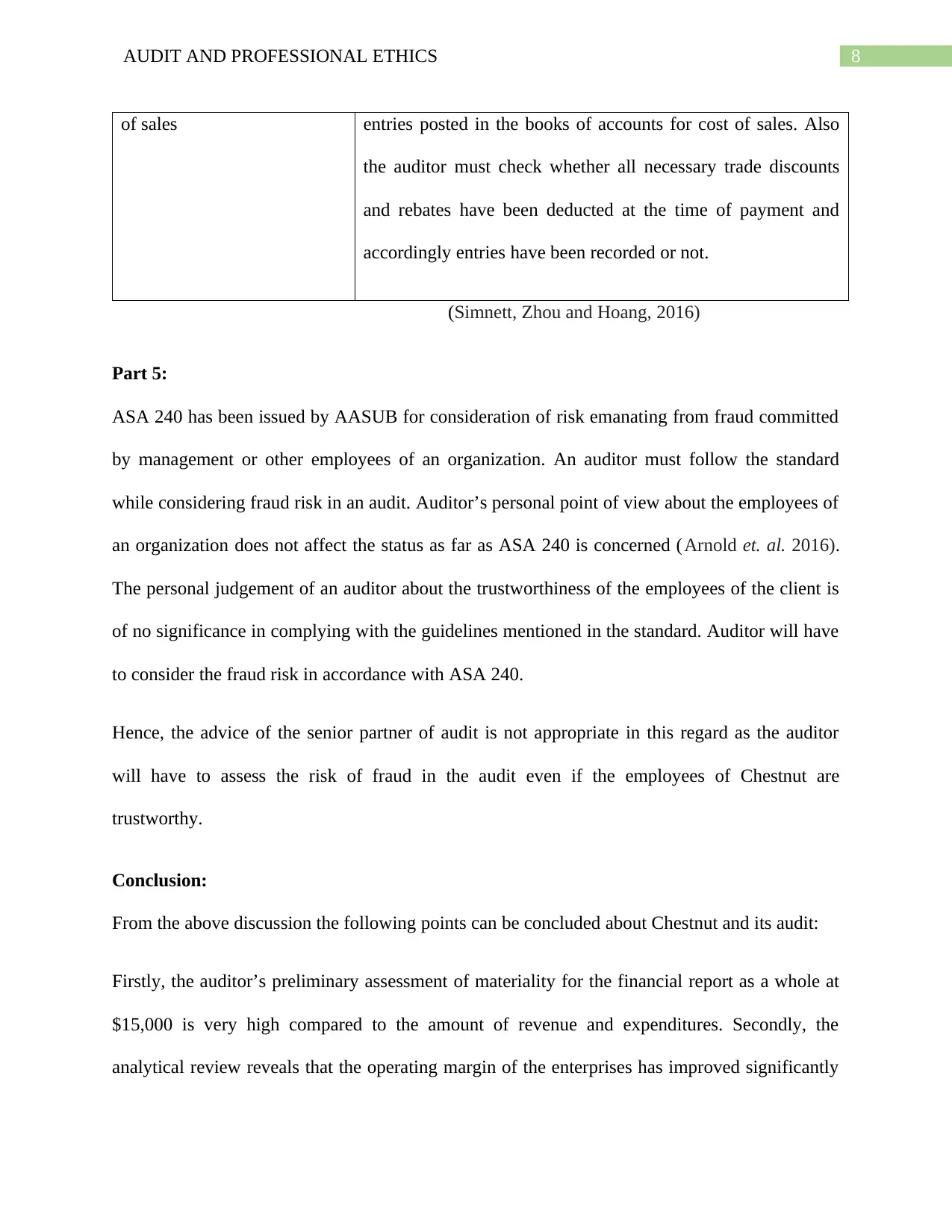
8AUDIT AND PROFESSIONAL ETHICS
of sales entries posted in the books of accounts for cost of sales. Also
the auditor must check whether all necessary trade discounts
and rebates have been deducted at the time of payment and
accordingly entries have been recorded or not.
(Simnett, Zhou and Hoang, 2016)
Part 5:
ASA 240 has been issued by AASUB for consideration of risk emanating from fraud committed
by management or other employees of an organization. An auditor must follow the standard
while considering fraud risk in an audit. Auditor’s personal point of view about the employees of
an organization does not affect the status as far as ASA 240 is concerned (Arnold et. al. 2016).
The personal judgement of an auditor about the trustworthiness of the employees of the client is
of no significance in complying with the guidelines mentioned in the standard. Auditor will have
to consider the fraud risk in accordance with ASA 240.
Hence, the advice of the senior partner of audit is not appropriate in this regard as the auditor
will have to assess the risk of fraud in the audit even if the employees of Chestnut are
trustworthy.
Conclusion:
From the above discussion the following points can be concluded about Chestnut and its audit:
Firstly, the auditor’s preliminary assessment of materiality for the financial report as a whole at
$15,000 is very high compared to the amount of revenue and expenditures. Secondly, the
analytical review reveals that the operating margin of the enterprises has improved significantly
of sales entries posted in the books of accounts for cost of sales. Also
the auditor must check whether all necessary trade discounts
and rebates have been deducted at the time of payment and
accordingly entries have been recorded or not.
(Simnett, Zhou and Hoang, 2016)
Part 5:
ASA 240 has been issued by AASUB for consideration of risk emanating from fraud committed
by management or other employees of an organization. An auditor must follow the standard
while considering fraud risk in an audit. Auditor’s personal point of view about the employees of
an organization does not affect the status as far as ASA 240 is concerned (Arnold et. al. 2016).
The personal judgement of an auditor about the trustworthiness of the employees of the client is
of no significance in complying with the guidelines mentioned in the standard. Auditor will have
to consider the fraud risk in accordance with ASA 240.
Hence, the advice of the senior partner of audit is not appropriate in this regard as the auditor
will have to assess the risk of fraud in the audit even if the employees of Chestnut are
trustworthy.
Conclusion:
From the above discussion the following points can be concluded about Chestnut and its audit:
Firstly, the auditor’s preliminary assessment of materiality for the financial report as a whole at
$15,000 is very high compared to the amount of revenue and expenditures. Secondly, the
analytical review reveals that the operating margin of the enterprises has improved significantly
⊘ This is a preview!⊘
Do you want full access?
Subscribe today to unlock all pages.

Trusted by 1+ million students worldwide
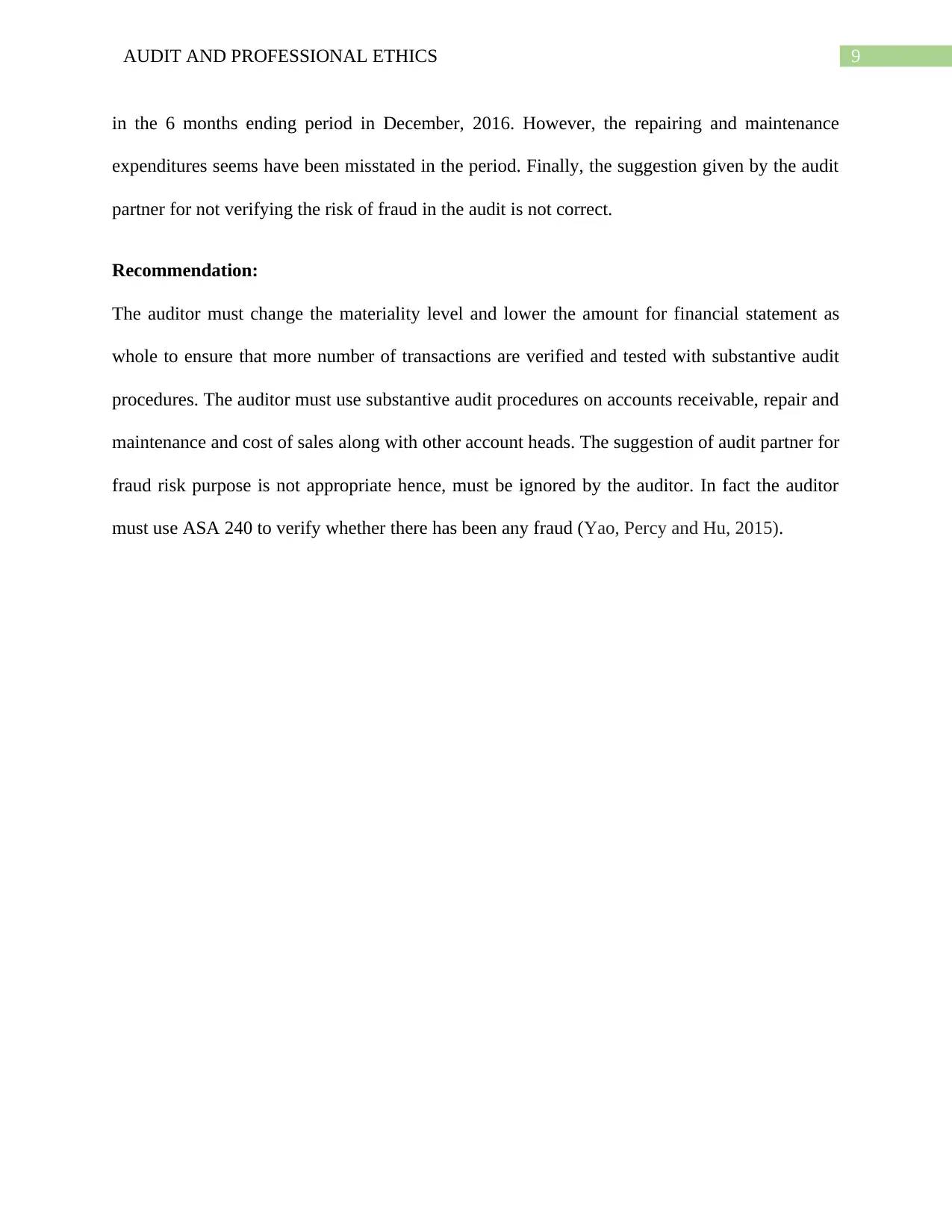
9AUDIT AND PROFESSIONAL ETHICS
in the 6 months ending period in December, 2016. However, the repairing and maintenance
expenditures seems have been misstated in the period. Finally, the suggestion given by the audit
partner for not verifying the risk of fraud in the audit is not correct.
Recommendation:
The auditor must change the materiality level and lower the amount for financial statement as
whole to ensure that more number of transactions are verified and tested with substantive audit
procedures. The auditor must use substantive audit procedures on accounts receivable, repair and
maintenance and cost of sales along with other account heads. The suggestion of audit partner for
fraud risk purpose is not appropriate hence, must be ignored by the auditor. In fact the auditor
must use ASA 240 to verify whether there has been any fraud (Yao, Percy and Hu, 2015).
in the 6 months ending period in December, 2016. However, the repairing and maintenance
expenditures seems have been misstated in the period. Finally, the suggestion given by the audit
partner for not verifying the risk of fraud in the audit is not correct.
Recommendation:
The auditor must change the materiality level and lower the amount for financial statement as
whole to ensure that more number of transactions are verified and tested with substantive audit
procedures. The auditor must use substantive audit procedures on accounts receivable, repair and
maintenance and cost of sales along with other account heads. The suggestion of audit partner for
fraud risk purpose is not appropriate hence, must be ignored by the auditor. In fact the auditor
must use ASA 240 to verify whether there has been any fraud (Yao, Percy and Hu, 2015).
Paraphrase This Document
Need a fresh take? Get an instant paraphrase of this document with our AI Paraphraser
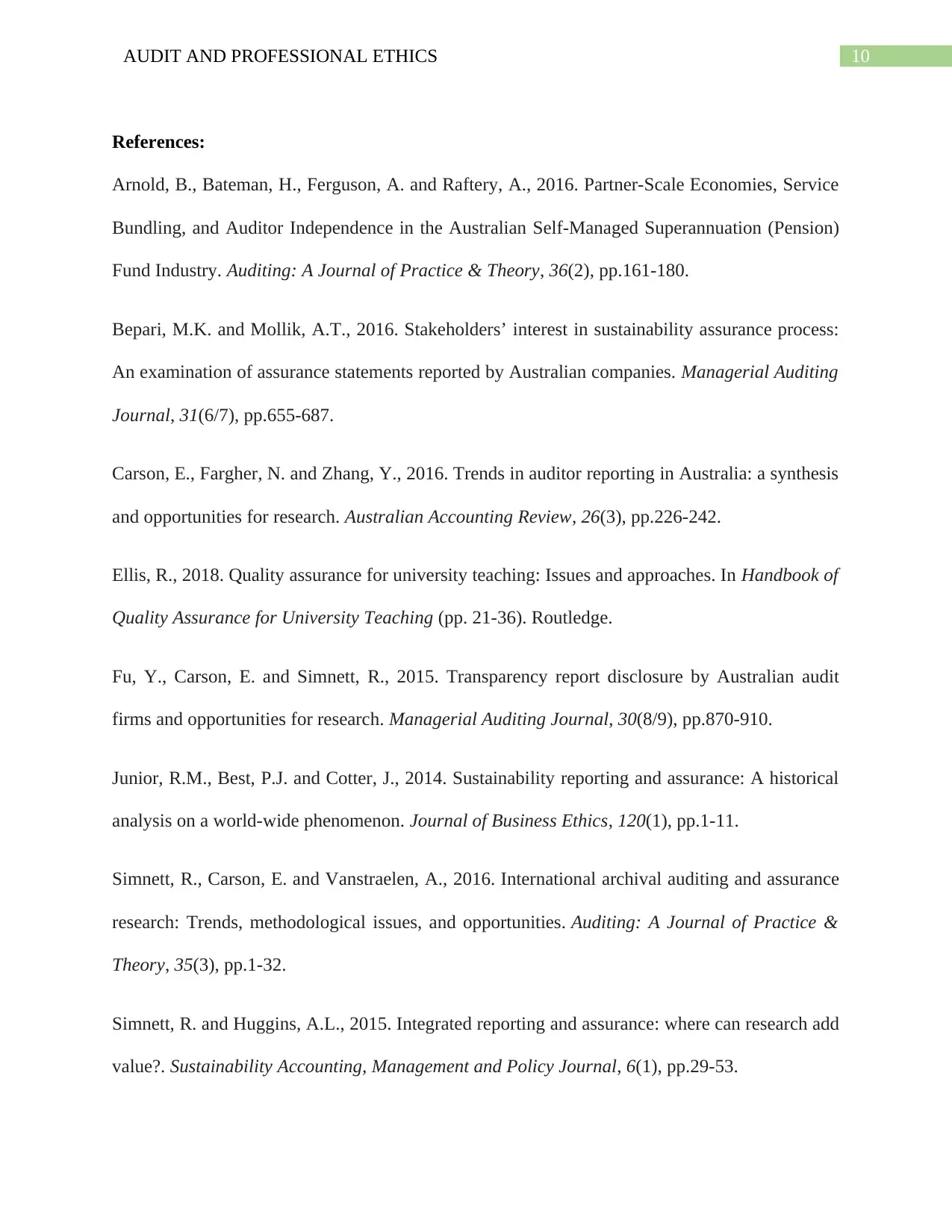
10AUDIT AND PROFESSIONAL ETHICS
References:
Arnold, B., Bateman, H., Ferguson, A. and Raftery, A., 2016. Partner-Scale Economies, Service
Bundling, and Auditor Independence in the Australian Self-Managed Superannuation (Pension)
Fund Industry. Auditing: A Journal of Practice & Theory, 36(2), pp.161-180.
Bepari, M.K. and Mollik, A.T., 2016. Stakeholders’ interest in sustainability assurance process:
An examination of assurance statements reported by Australian companies. Managerial Auditing
Journal, 31(6/7), pp.655-687.
Carson, E., Fargher, N. and Zhang, Y., 2016. Trends in auditor reporting in Australia: a synthesis
and opportunities for research. Australian Accounting Review, 26(3), pp.226-242.
Ellis, R., 2018. Quality assurance for university teaching: Issues and approaches. In Handbook of
Quality Assurance for University Teaching (pp. 21-36). Routledge.
Fu, Y., Carson, E. and Simnett, R., 2015. Transparency report disclosure by Australian audit
firms and opportunities for research. Managerial Auditing Journal, 30(8/9), pp.870-910.
Junior, R.M., Best, P.J. and Cotter, J., 2014. Sustainability reporting and assurance: A historical
analysis on a world-wide phenomenon. Journal of Business Ethics, 120(1), pp.1-11.
Simnett, R., Carson, E. and Vanstraelen, A., 2016. International archival auditing and assurance
research: Trends, methodological issues, and opportunities. Auditing: A Journal of Practice &
Theory, 35(3), pp.1-32.
Simnett, R. and Huggins, A.L., 2015. Integrated reporting and assurance: where can research add
value?. Sustainability Accounting, Management and Policy Journal, 6(1), pp.29-53.
References:
Arnold, B., Bateman, H., Ferguson, A. and Raftery, A., 2016. Partner-Scale Economies, Service
Bundling, and Auditor Independence in the Australian Self-Managed Superannuation (Pension)
Fund Industry. Auditing: A Journal of Practice & Theory, 36(2), pp.161-180.
Bepari, M.K. and Mollik, A.T., 2016. Stakeholders’ interest in sustainability assurance process:
An examination of assurance statements reported by Australian companies. Managerial Auditing
Journal, 31(6/7), pp.655-687.
Carson, E., Fargher, N. and Zhang, Y., 2016. Trends in auditor reporting in Australia: a synthesis
and opportunities for research. Australian Accounting Review, 26(3), pp.226-242.
Ellis, R., 2018. Quality assurance for university teaching: Issues and approaches. In Handbook of
Quality Assurance for University Teaching (pp. 21-36). Routledge.
Fu, Y., Carson, E. and Simnett, R., 2015. Transparency report disclosure by Australian audit
firms and opportunities for research. Managerial Auditing Journal, 30(8/9), pp.870-910.
Junior, R.M., Best, P.J. and Cotter, J., 2014. Sustainability reporting and assurance: A historical
analysis on a world-wide phenomenon. Journal of Business Ethics, 120(1), pp.1-11.
Simnett, R., Carson, E. and Vanstraelen, A., 2016. International archival auditing and assurance
research: Trends, methodological issues, and opportunities. Auditing: A Journal of Practice &
Theory, 35(3), pp.1-32.
Simnett, R. and Huggins, A.L., 2015. Integrated reporting and assurance: where can research add
value?. Sustainability Accounting, Management and Policy Journal, 6(1), pp.29-53.
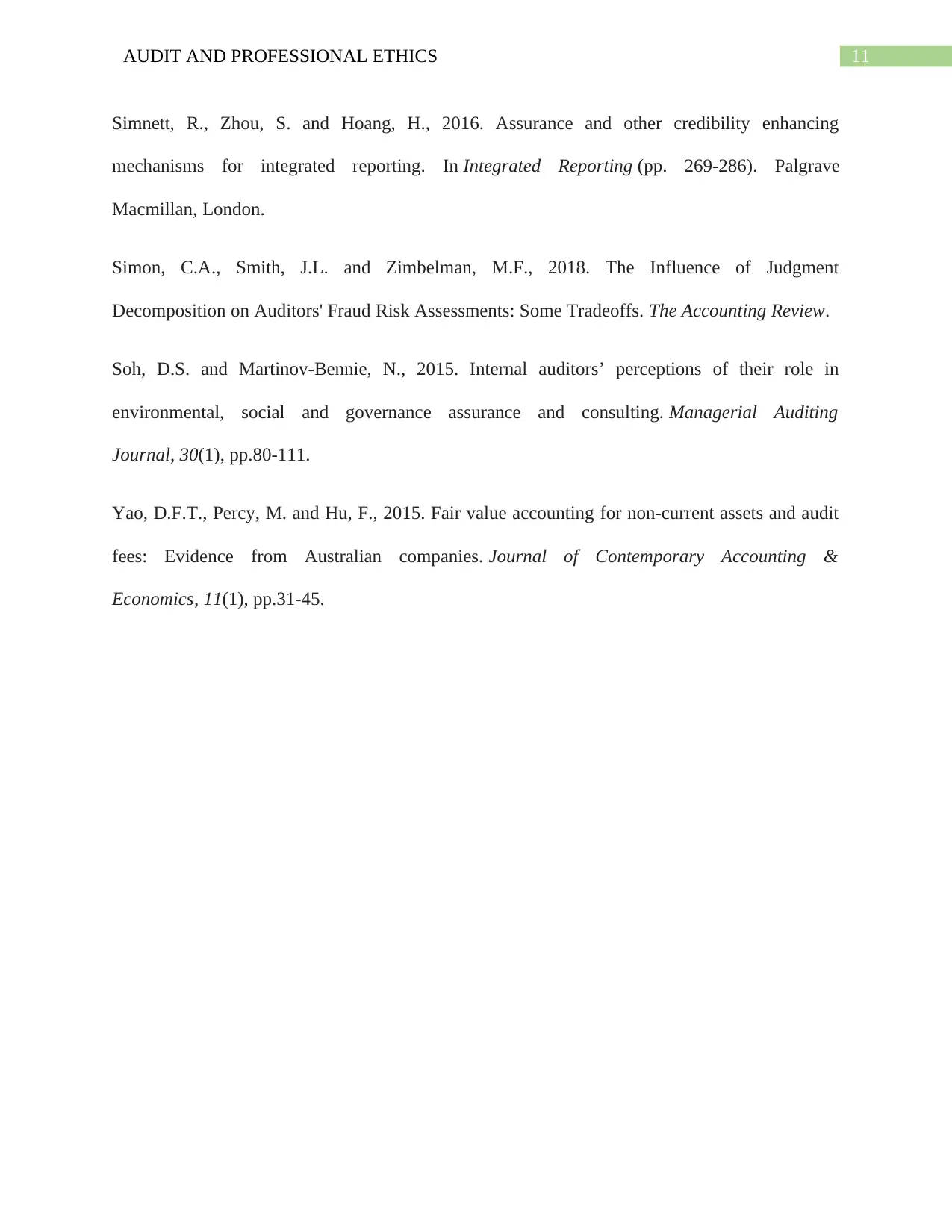
11AUDIT AND PROFESSIONAL ETHICS
Simnett, R., Zhou, S. and Hoang, H., 2016. Assurance and other credibility enhancing
mechanisms for integrated reporting. In Integrated Reporting (pp. 269-286). Palgrave
Macmillan, London.
Simon, C.A., Smith, J.L. and Zimbelman, M.F., 2018. The Influence of Judgment
Decomposition on Auditors' Fraud Risk Assessments: Some Tradeoffs. The Accounting Review.
Soh, D.S. and Martinov-Bennie, N., 2015. Internal auditors’ perceptions of their role in
environmental, social and governance assurance and consulting. Managerial Auditing
Journal, 30(1), pp.80-111.
Yao, D.F.T., Percy, M. and Hu, F., 2015. Fair value accounting for non-current assets and audit
fees: Evidence from Australian companies. Journal of Contemporary Accounting &
Economics, 11(1), pp.31-45.
Simnett, R., Zhou, S. and Hoang, H., 2016. Assurance and other credibility enhancing
mechanisms for integrated reporting. In Integrated Reporting (pp. 269-286). Palgrave
Macmillan, London.
Simon, C.A., Smith, J.L. and Zimbelman, M.F., 2018. The Influence of Judgment
Decomposition on Auditors' Fraud Risk Assessments: Some Tradeoffs. The Accounting Review.
Soh, D.S. and Martinov-Bennie, N., 2015. Internal auditors’ perceptions of their role in
environmental, social and governance assurance and consulting. Managerial Auditing
Journal, 30(1), pp.80-111.
Yao, D.F.T., Percy, M. and Hu, F., 2015. Fair value accounting for non-current assets and audit
fees: Evidence from Australian companies. Journal of Contemporary Accounting &
Economics, 11(1), pp.31-45.
⊘ This is a preview!⊘
Do you want full access?
Subscribe today to unlock all pages.

Trusted by 1+ million students worldwide
1 out of 12
Related Documents
Your All-in-One AI-Powered Toolkit for Academic Success.
+13062052269
info@desklib.com
Available 24*7 on WhatsApp / Email
![[object Object]](/_next/static/media/star-bottom.7253800d.svg)
Unlock your academic potential
Copyright © 2020–2025 A2Z Services. All Rights Reserved. Developed and managed by ZUCOL.




